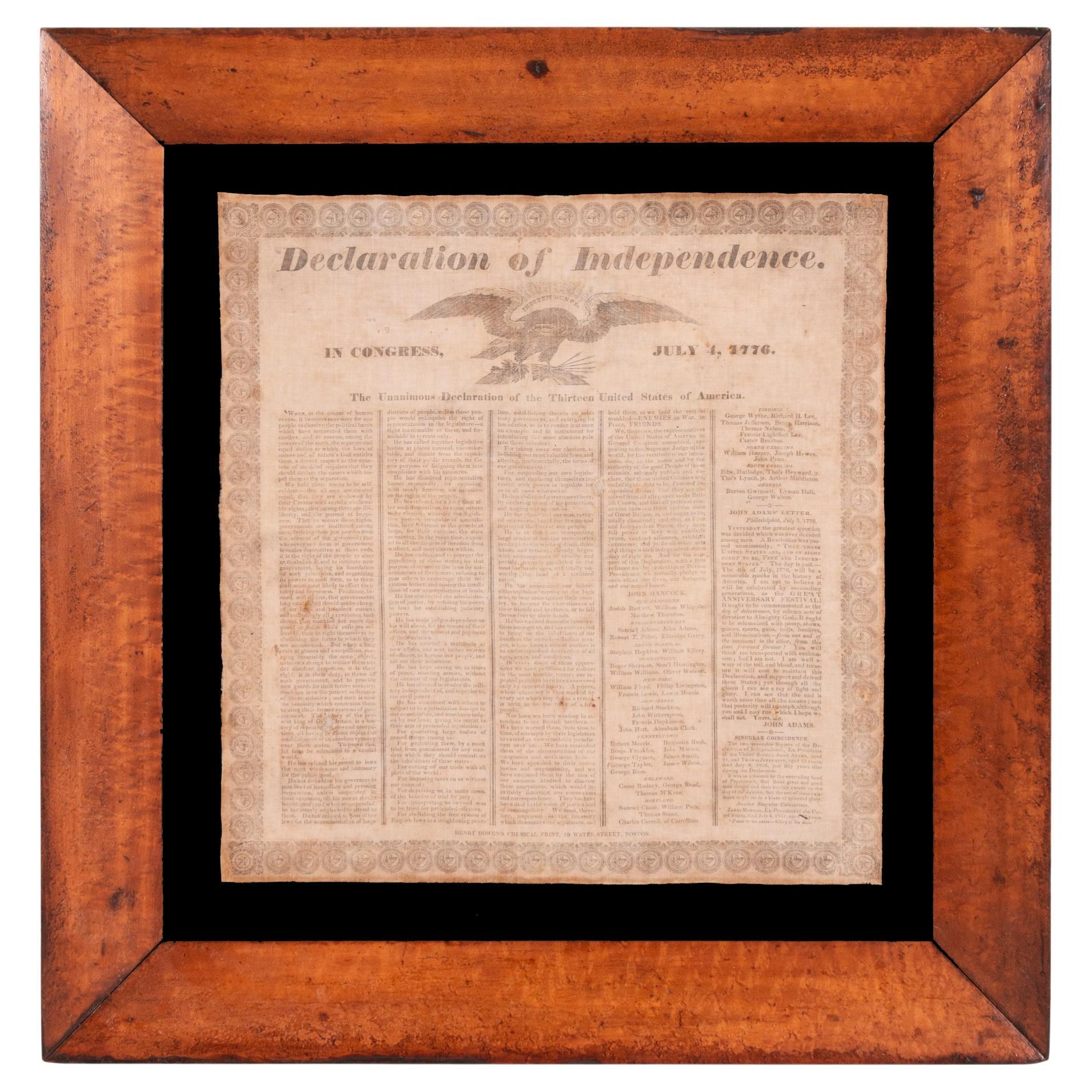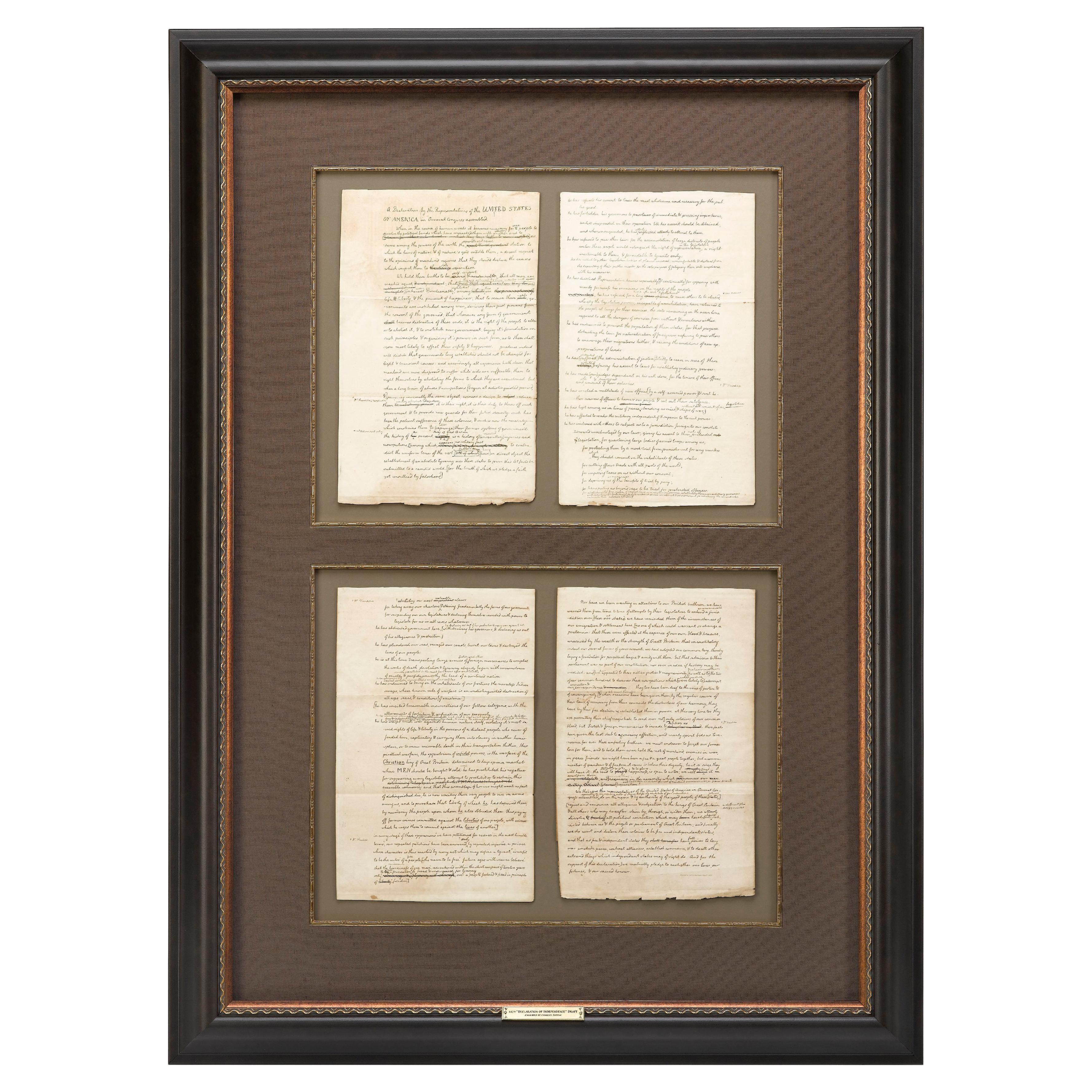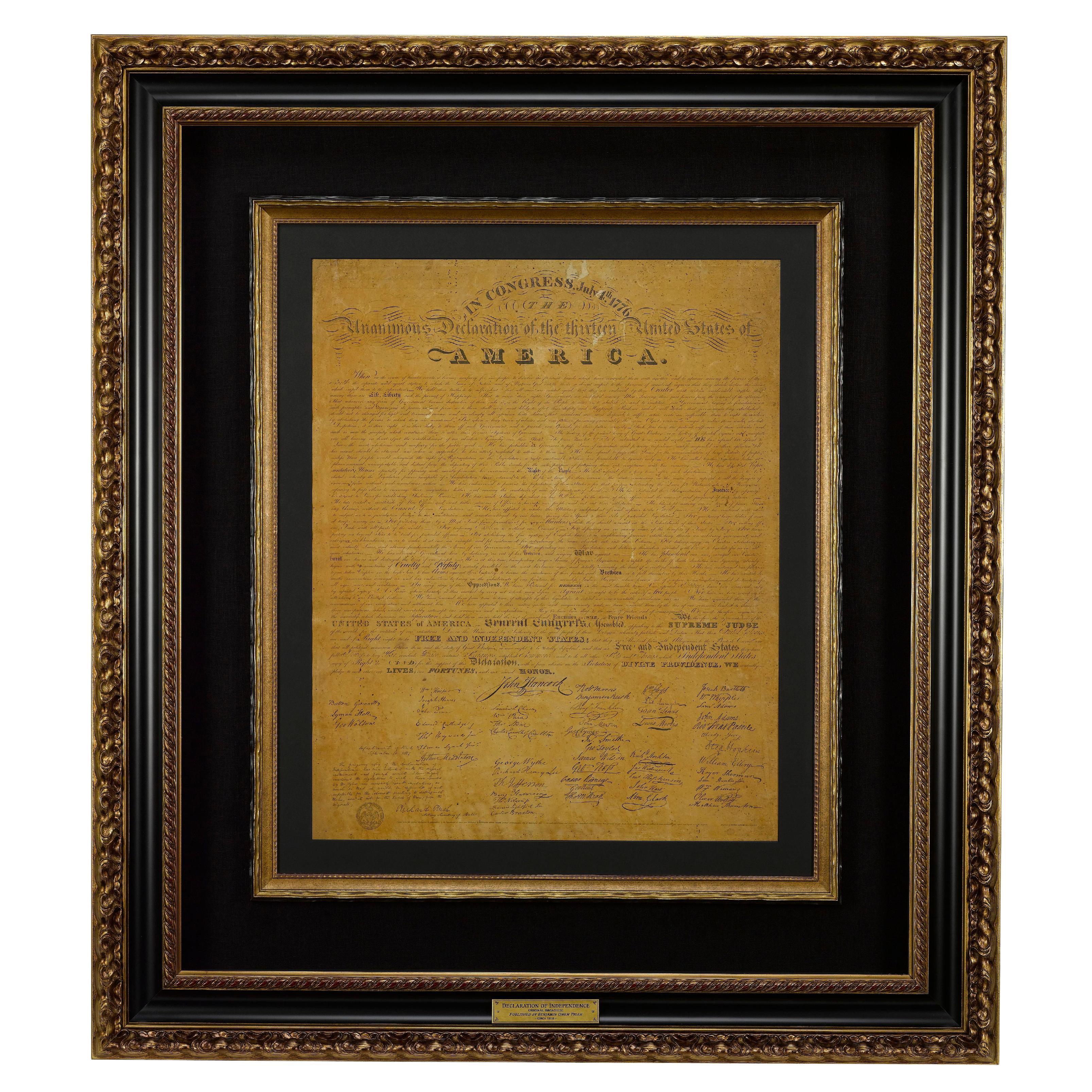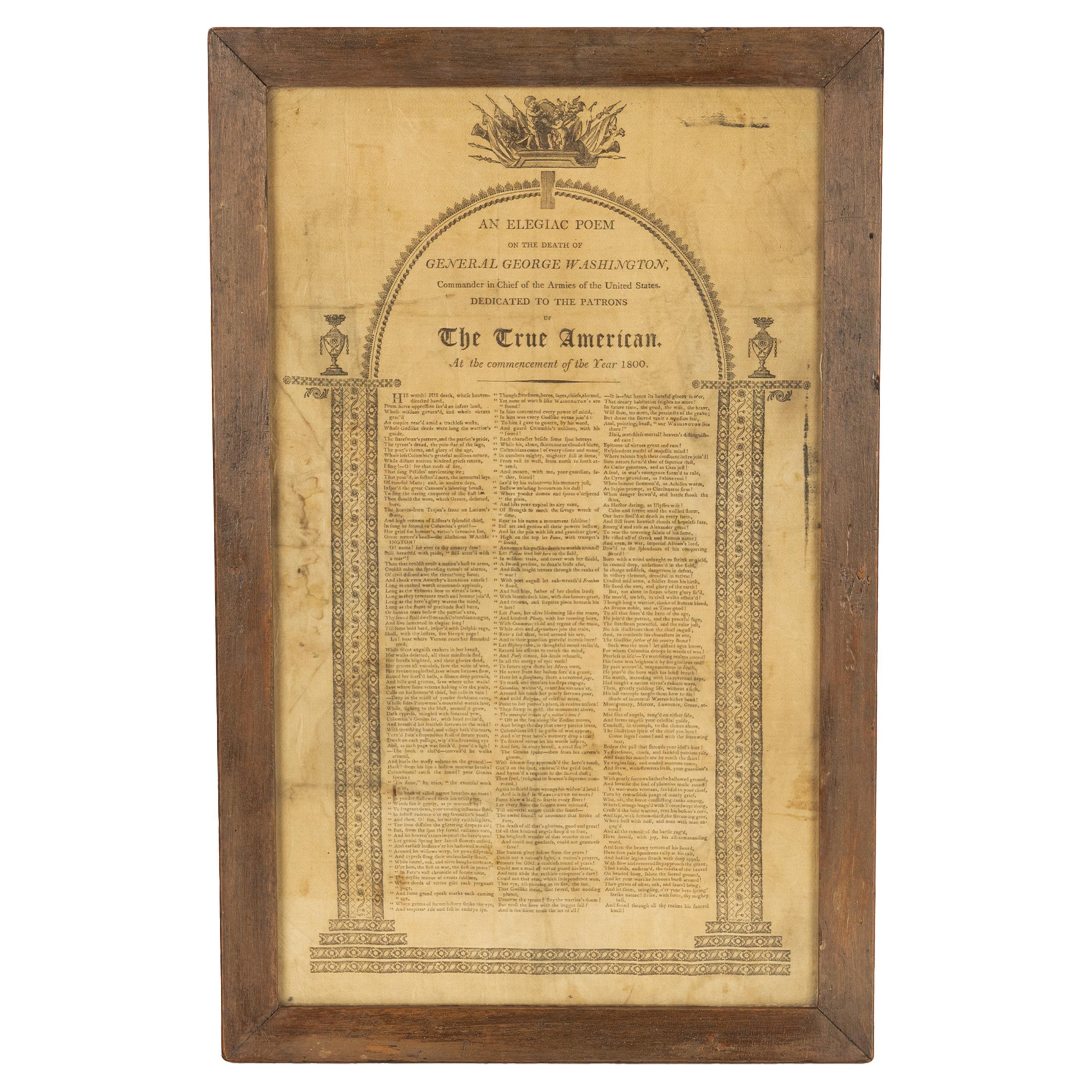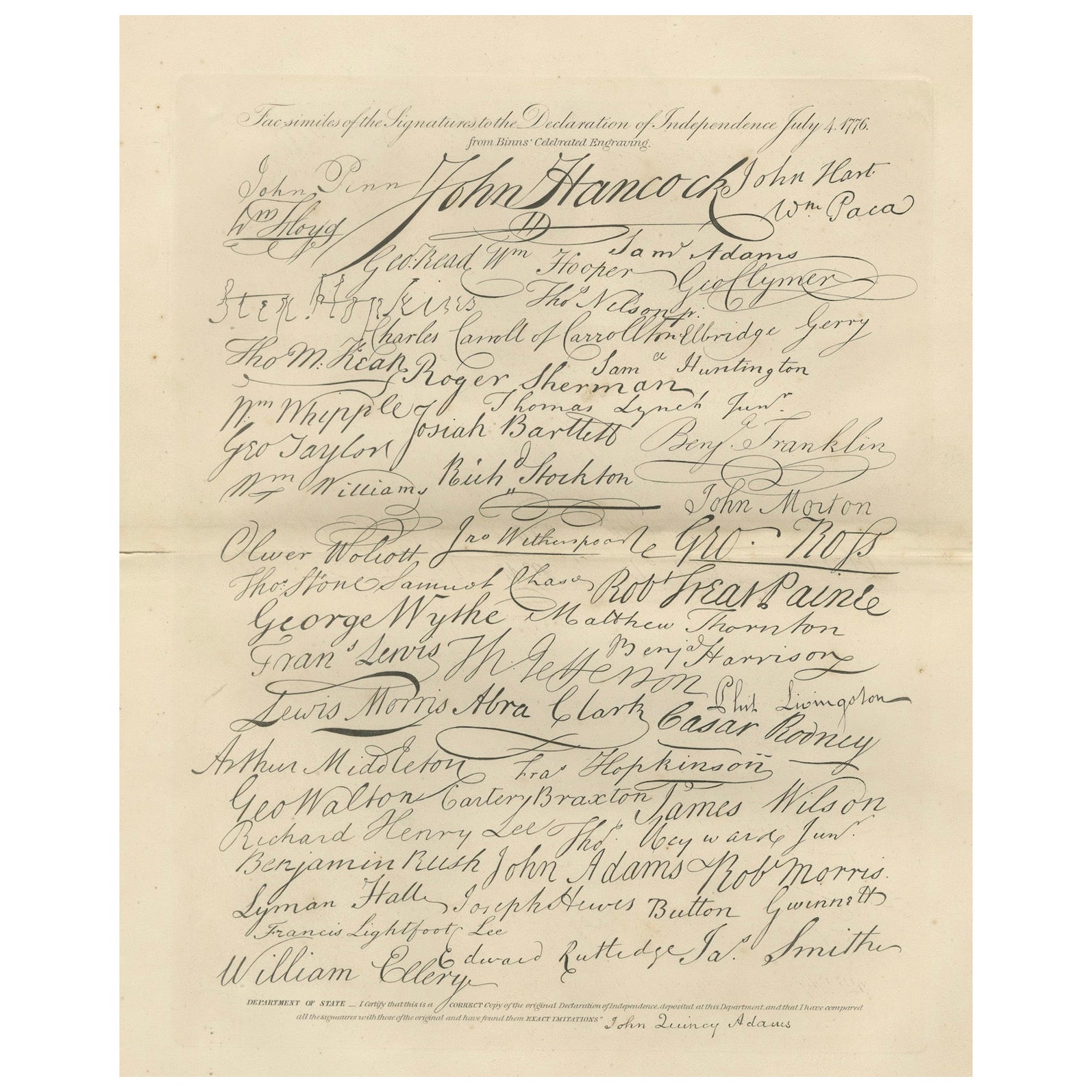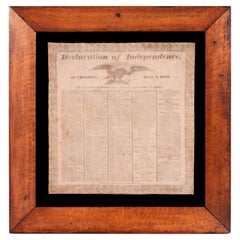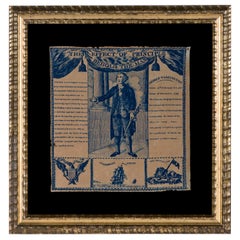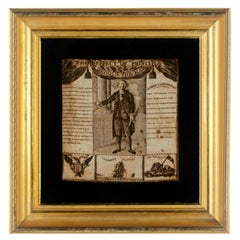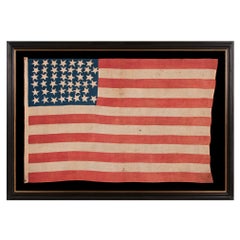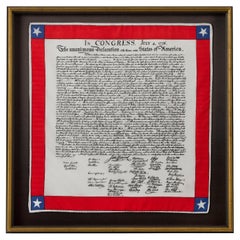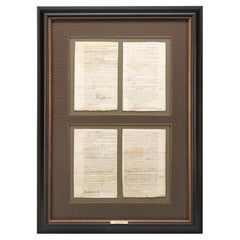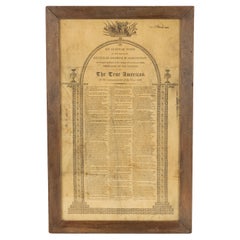Items Similar to The Declaration of Independence, Printed on Cotton, ca 1876
Want more images or videos?
Request additional images or videos from the seller
1 of 6
The Declaration of Independence, Printed on Cotton, ca 1876
Price Upon Request
Price Upon Request
Price Upon Request
Price Upon Request
Price Upon Request
Price Upon Request
Price Upon Request
Price Upon Request
Price Upon Request
Price Upon Request
Shipping
Retrieving quote...The 1stDibs Promise:
Authenticity Guarantee,
Money-Back Guarantee,
24-Hour Cancellation
About the Item
PRINTED COTTON KERCHIEF GLORIFYING THE DECLARATION OF INDEPENDENCE, WITH TEXT AND REPRODUCED SIGNATURES, MADE FOR THE 1876 CENTENNIAL INTERNATIONAL EXPOSITION IN PHILADELPHIA
Printed on cotton, this beautiful kerchief pays homage to the Declaration of Independence, through the reproduction of its text and 56 signatures, surrounded by a fanciful border. The latter contains the 13 state seals, which are dispersed around the perimeter in small medallion images. Note how Pennsylvania is highlighted among them, larger and in the bottom center, both because it served as the meeting place of the Second Continental Congress, and played host to the 1876 Centennial International Exposition, the six-month long World’s Fair event that was held in honor of our nation’s 100-year anniversary of independence.
The names of twelve Revolutionary War generals are spread out between each crest, on each forward-facing turn of a scroll, that wraps around the pillar and leaf border on the right, left, and bottom. These include Washington, Lafayette, Johann de Kalb, Nathiel Greene, Ethan Allen, Henry Knox, Israel Putnam, Daniel Morgan, William Moultrie, Francis Marion, Mad Anthony Wayne, and Thomas Sumter (note the misspelling of the surname of the latter).
The top is crowned by an image of the Liberty Bell with outstretched sprigs of olive and oak branches. The scarlet red border creates nice contrast with the sepia text and illustrations and the white background.
An example of the bandanna, in the collection of Cornell University, is pictured in “Threads of History” by Herbert Ridgeway Collins (Smithsonian Press, 1979), as item 419, on p. 200. Collins formerly served as curator of political history at the Smithsonian and his text is considered the definitive reference on American political textiles. I have many times seen this kerchief sewn into quilts produced in the patriotism fueled by the centennial, but oddly enough, loose examples such as this are scarcely encountered. The same textile exists with a blue border instead of red.
Mounting: The kerchief was mounted and framed within our own conservation department, which is led by expert staff. We take great care in the mounting and preservation of flags and banners and have framed thousands of examples.
The kerchief has been hand-stitched to a background of 100% cotton twill, black in color, that has been washed and treated for color fastness. The mount has been placed in a scooped profile molding, very dark brown in color, nearly black, with reddish highlights and undertones, to which a black-painted, hand-gilded, and distressed Italian molding was added as a cap. The glazing is U.V. protective acrylic (Plexiglas).
Condition: There are 4, small, spots of modest staining, plus more minor flecks of staining elsewhere. There is minor to modest fading of the red pigment in the center of the textile, vertically, and there is a streak of significant misprinting near the left edge, running vertically through the state devices.
- Dimensions:Height: 30.75 in (78.11 cm)Width: 30 in (76.2 cm)Depth: 3 in (7.62 cm)
- Materials and Techniques:
- Place of Origin:
- Period:
- Date of Manufacture:1876
- Condition:See Item Description.
- Seller Location:York County, PA
- Reference Number:Seller: ker-2441stDibs: LU849744272752
About the Seller
5.0
Recognized Seller
These prestigious sellers are industry leaders and represent the highest echelon for item quality and design.
Established in 1991
1stDibs seller since 2008
70 sales on 1stDibs
Typical response time: 1 to 2 days
- ShippingRetrieving quote...Shipping from: York County, PA
- Return Policy
Authenticity Guarantee
In the unlikely event there’s an issue with an item’s authenticity, contact us within 1 year for a full refund. DetailsMoney-Back Guarantee
If your item is not as described, is damaged in transit, or does not arrive, contact us within 7 days for a full refund. Details24-Hour Cancellation
You have a 24-hour grace period in which to reconsider your purchase, with no questions asked.Vetted Professional Sellers
Our world-class sellers must adhere to strict standards for service and quality, maintaining the integrity of our listings.Price-Match Guarantee
If you find that a seller listed the same item for a lower price elsewhere, we’ll match it.Trusted Global Delivery
Our best-in-class carrier network provides specialized shipping options worldwide, including custom delivery.More From This Seller
View AllDeclaration of Independence on Cloth, Printed in Boston 1832
Located in York County, PA
COPY OF THE DECLARATION OF INDEPENDENCE ON CLOTH, PRINTED IN BOSTON IN 1832 TO MEMORIALIZE THE PASSING OF THE LAST SURVIVING SIGNER, CHARLES CARROLL OF MARYLAND, IN THE YEAR THAT COI...
Category
Antique 1830s American Political and Patriotic Memorabilia
Materials
Cotton
Price Upon Request
1806 Printed Linen Kerchief Glorifying George Washington, Germantown, Penn
Located in York County, PA
EXTRAORDINARILY EARLY (1806) PRINTED LINEN KERCHIEF GLORIFYING GEORGE WASHINGTON, PRINT WORKS, GERMANTOWN, PENNSYLVANIA
Printed in blue ink on coarse, white linen, this patriotic kerchief shows a standing portrait of George Washington, above which is a swag valance and the words “The Effect of Principle, Behold the Man”. The portrait is based on a mezzotint after Gilbert Stuart’s very famous painting of Washington in his later years, most often referred to as the Landsdowne portrait. Stuart painted three versions of it in oil on canvas, one of which was completed in 1796 for a wealthy merchant by the name of William Constable, who commissioned the work for Alexander Hamilton.
The kerchief is interesting because it is both American-made and documented. This is exceptionally unusual for any printed textile of the 19th century or prior and the earlier the time period the more unlikely an object is to be identified. This kerchief and a companion piece entitled “The Love of Truth Mark the Boy” (also glorifying Washington, through the fabled story of the cherry tree), were made circa 1806 by Germantown Print Works in Germantown, Pennsylvania.
To the left of Washington's image is a portion of his infamous farewell address to his troops at the end of the Revolutionary War. To the right is a short excerpt from his eulogy. Below these are three images. In the center is a square-rigged tall ship with “Commercial Union” above it, flanked by the American eagle on the left and the British lion on the right. It is reasonable to assume that the textile may have been produced in demonstration of the maker's desire, and/or that of others, to advance trade with England. Commercial printers were very influential in early America, as they possessed the means by which to disseminate information.
This kerchief and its companion piece are documented in Threads of History, Americana Recorded on Cloth, 1775 - the Present, by Herbert Ridgeway Collins (1979, Smithsonian Press), p. 63, items 38 & 39.* The two pieces pictured are in the collection of Cornell University, but the Collins text also cites an uncut pair to be present in the collection of the Western Reserve Historical Society, Cleveland, OH. The name "Germantown Print Works" is printed on the Western Reserve examples. Another example of the textile in question is documented in "Running for President, The Candidates and Their Images, 1789-1896" by Schlesinger, Israel, and Frendt, (1994, Simon & Schuster), p. 15.
I have seen three different color variations of this textile, including sepia, mulberry red, and blue. This particular example has a hand-sewn binding along the top, lower, and left edges.
Mounting: The textile was mounted and framed within our own conservation department, which is led by expert staff. We take great care in the mounting and preservation of flags and have framed thousands of examples.
The gilded molding has a rippled profile and dates to the period between 1825 and 1850.The background is 100% cotton twill, black in color. The glazing is U.V. protective plexiglass. Feel free to contact us for more details.
Condition: There is an all-over golden oxidation of the white fabric and there is very minor staining. There are tiny tack holes in each corner and there are minor nicks around the perimeter.
* Collins relates that Germantown Printworks was operated by the Hewsons. In doing so he cites one of Worthington Chauncey Ford's books on George Washington, but it isn't clear which one (there are many) and no page numbers are given. John Hewson was an Englishman who came to America and opened his printing business on the advice of Benjamin Franklin. He was one of the first “calico printers” and is the earliest documented to have advertised printed kerchiefs. His ads for bandanas appear as early as June 20th, 1774. He is suspected of having produced the very first American kerchief that pictured an American president, which is documented in Collins as item 1 on page 48. Linda Eaton, curator at Winterthur, in 2012, is currently doing in depth research on the three printers of fabrics that were operating in Germantown in early America. She discovered that the owner and/or operator of Germantown Print Works, while not currently known, was not John Hewson. This information is not yet published. She also noted that Winterthur possessed examples of the two George Washington textiles...
Category
Antique Early 1800s American Political and Patriotic Memorabilia
Materials
Cotton
Printed Linen Kerchief of George Washington, ca 1806, Germantown, PA
Located in York County, PA
Extraordinarily early (1806) printed linen kerchief glorifying George Washington, Germantown print works, Germantown, Pennsylvania
Printed in sepia ink on coarse, white linen, this patriotic kerchief shows a standing portrait of George Washington, above which is a swag valance and the words “The Effect of Principle, Behold the Man”. The portrait is based on a mezzotint after Gilbert Stuart’s very famous painting of Washington in his later years. Stuart painted it in oil on canvas for a wealthy merchant by the name of William Constable, who commissioned the work for Alexander Hamilton.
The kerchief is interesting because it is both American-made and documented. This is exceptionally unusual for any printed textile of the 19th century or prior and the earlier the time period the more unlikely an object is to be identified. This kerchief and a companion piece entitled “The Love of Truth Mark the Boy” (also glorifying Washington through the fabled story of the cherry tree), were made ca 1806 by Germantown Print Works in Germantown, Pennsylvania.
To the left of Washington's image is a portion of his infamous farewell address to his troops at the end of the Revolutionary War. To the right is a short excerpt from his eulogy. Below these are three images. In the center is a square-rigged tall ship with “Commercial Union” above it, flanked by the American eagle on the left and the British lion...
Category
Antique Early 19th Century American Political and Patriotic Memorabilia
Materials
Linen
Homemade, Antique American Flag with Exceptional Folk Qualities, 1896-1908
Located in York County, PA
HOMEMADE, ANTIQUE AMERICAN FLAG WITH A TINY CANTON RESTING ON THE 6TH STRIPE AND AN EXTREMELY FOLKY PRESENTATION OF 45 STARS IN A “NOTCHED” PATTERN THAT MIGHT BE UNIQUE TO THIS EXAMP...
Category
Antique 1890s American Political and Patriotic Memorabilia
Materials
Cotton
30 Star Antique American Parade Flag, Wisconsin Statehood, ca 1848-1850
Located in York County, PA
ANTIQUE AMERICAN PARADE FLAG WITH 30 STARS, THE ONLY KNOWN EXAMPLE IN THIS SIMPLE BUT EXTRAORDINARY STYLE, PRE-CIVIL WAR, OFFICIAL FOR JUST TWO YEARS, REFLECTS THE ADDITION OF WISCON...
Category
Antique Mid-19th Century American Political and Patriotic Memorabilia
Materials
Cotton
Price Upon Request
38 Star Antique American Parade Flag, Colorado Statehood, ca 1876-1889
Located in York County, PA
38 STAR ANTIQUE AMERICAN PARADE FLAG WITH JUSTIFIED ROWS OF 7-6-6-6-6-7 AND SCATTERED STAR ORIENTATION, MADE DURING THE PERIOD WHEN COLORADO WAS THE MOST RECENT STATE TO JOIN THE UNION, 1876-1889
38 star American national parade flag, printed on coarse cotton, possibly with flax content. One of the flag’s most interesting features is the wild sweep of the grain of the fabric, the warp and weft of which are anything but perpendicular.
The stars are arranged in justified rows of 7-6-6-6-6-7. This results in a secondary pattern that I commonly call a “box-in-a-box-in-a-box”, because of the way in which the seemingly haphazard arrangement creates three consecutive squares. Note how the stars point in various directions on their vertical axis, which adds a nice element of folk quality to the overall design.
Most parade flags in this star count have red stripes that lean heavily toward orange, with a vibrant, chromatic luster. This was common across printed flags produced between the 1850's and the 38 star period, phasing out in the last decade of the 19th century. Also note how the wear and patina contribute to an endearing presentation that displays its long-term use gracefully.
Colorado became the 38th state on August 1st, 1876. This was the year of our nation’s 100-year anniversary of independence. Per the Third Flag Act of 1818, stars were not officially added until the 4th of July following a state's addition. For this reason, 37 was the official star count for the American flag in 1876. In the latter 19th century, it became common to add stars before the respective state(s) had even entered the Union. No one cared what was official, not even the military, where the matter of practicality with regard to flags always seems to have outweighed regulations. In the private sector, commercial flag-making was a competitive venture. Few flag-makers continued to produce 37 star flags when their competitors had jumped the star count to 38. It is for this reason that 38 and 13 stars (to represent the original 13 colonies) are more often seen at the Centennial International Exposition, the six-month long World’s Fair, held in Philadelphia, that served as the nucleus of the national celebration.
Some makers of printed parade flags actually began to produce 39 star flags in 1876, in hopeful anticipation of the addition of two more Western Territories instead of one. The 39th state would not join the Union for another 13 years, however, when the Dakota Territory—thought to be coming as a single state—entered as two separate states on November 2nd, 1889. The 38 star flag generally fell out of production at that time, though it technically remained official until July 3rd, 1890.
President Ulysses S. Grant was in office when the first 38 star flags would have appeared. The list of presidents that served during the period when the 38 star flag was official include Rutherford B. Hayes, James Garfield...
Category
Antique Late 19th Century American Political and Patriotic Memorabilia
Materials
Cotton
Price Upon Request
You May Also Like
Declaration of Independence Printed Scarf
Located in Colorado Springs, CO
Presented is a patriotic silk scarf, celebrating the Declaration of Independence. At center of the silk scarf design is artistic rendering of the Declaration of Independence. The famous text and signatures are printed in black ink on white silk. A border of bright red encloses the text, with a five-pointed white star set against a blue square appearing at each corner. This is a newly made silk scarf, printed to celebrate our Nation's foundational text.
The United States Declaration of Independence...
Category
21st Century and Contemporary American Tapestries
Materials
Silk
1829 "Declaration of Independence" Draft, Engraved by Charles Toppan
Located in Colorado Springs, CO
This historical and rare item celebrates one of the most influential writers, politicians, and American Revolutionary figures, Thomas Jefferson. Featured is a four-page facsimile ste...
Category
Antique 1820s American Federal Prints
Materials
Paper
1818 Declaration of Independence Broadside Engraved by Benjamin Owen Tyler
Located in Colorado Springs, CO
This is a stunning 1818 engraving of the Declaration of Independence, the first engraved broadside of our nation’s founding document. The year 1815 saw the conclusion of the United S...
Category
Antique 1810s American Federal Prints
Materials
Paper
Antique Silk Broadside An Elegiac Poem Death of President George Washington 1800
Located in Portland, OR
An important & rare antique American political printed silk broadside, an elegy on the death of President George Washington, dated 1800.
A poem on the Death of President George Was...
Category
Antique 1790s Federal Political and Patriotic Memorabilia
Materials
Silk
Declaration of Independence Signatures Facsimile – Binns Engraving, 1850s
Located in Langweer, NL
Declaration of Independence Signatures Facsimile – Binns Engraving, 1820s
This antique facsimile presents the signatures of the signers of the Declaration of Independence, July 4, 1...
Category
Antique 1850s Prints
Materials
Paper
Declaration of Independence Signing Painting
Located in Queens, NY
Copy of painting titled "Declaration of Independence" John Adams, Robert Sherman, Thomas Jefferson (presenting the document), and Benjamin Franklin--standing before John Hancock
Category
Late 20th Century American Victorian Paintings
Materials
Paint
More Ways To Browse
Oak Branch
Small Pillars
Mount Of Olives
Revolutionary War Antique
Antique Scooper
Antique Scoops
Henry V
Thomas Crown
Centennial 1876
American Flag Cotton
Small American Flag
Black And White Quilts
Great Seal Of The United States
Pillar And Scroll
Antique American Quilts
Six Nations
Declaration Of Independence
Antique Quilting Frames
